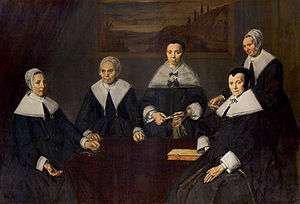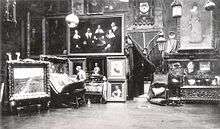Regentesses of the Old Men's Almshouse
The Regentesses of the Old Men's Almshouse Haarlem is a regents' group portrait of four regentesses and their servant painted by Frans Hals for the Oude Mannenhuis in Haarlem, the Netherlands. It forms a pendant with the Regents of the Old Men's Almshouse.

Background
The regentesses portrayed were (left to right) Adriaentje Schouten, Marijtje Willemsdr (also recorded as regentess of Het Dolhuys), Anna van Damme (first married Abraham de Ridder, then in 1650 married Salomon Cousaert), Adriana Bredenhof (wife of the schout Mattheus Everswijn).[1][2]
Frans Hals painted them in his "loose style", with rough brush strokes. The painting is traditionally dated 1664, though no archival evidence has yet been found to confirm this. The lack of any meticulous finishing, unusual in Hals' portraits of women, lead experts to assume this was painted towards the end of his life when he painted more loosely than in his younger years. The style of the women's dress also places the portrait well past the millstone collars of the 1640s and earlier. The painting currently hangs in the same location for which it was painted, namely the old men's almshouse in Haarlem known today as the Frans Hals Museum. According to Pieter Biesboer, the landscape painting on the rear wall is unidentified, but could possibly be an allegorical representation of the Good Samaritan, though no figures can be seen in it.[2][3]
19th century copies
In the 19th-century when Hals' loose brushwork became popular with impressionists, several copies were made of this painting:
 Edouard Manet made a copy upon his visit recorded on 26 June 1872
Edouard Manet made a copy upon his visit recorded on 26 June 1872 John Singer Sargent made a copy of the right portion
John Singer Sargent made a copy of the right portion William Merritt Chase made a copy which he hung in his studio on Tenth Street, New York
William Merritt Chase made a copy which he hung in his studio on Tenth Street, New York
Max Lieberman also made a copy of one of the heads.[4][2] James Abbott McNeill Whistler visited in 1882, 1885, and in 1902 to study the Frans Hals paintings, and according to a witness of his last visit, was "completely charmed by the old women".[5] The copy by Manet was discovered in 2018 and shown at the Frans Hals Museum during their 2018 exhibition Frans Hals and the Moderns. Like other copies after Hals' work, the copy gives insights into the state of the painting during Manet's time.[6]
References
- Painting record 10892 in the RKD
- Catalog number 86, Frans Hals, by Seymour Slive (editor), with contributions by Pieter Biesboer, Martin Bijl, Karin Groen and Ella Hendriks, Michael Hoyle, Frances S. Jowell, Koos Levy-van Halm and Liesbeth Abraham, Bianca M. Du Mortier, Irene van Thiel-Stroman, Prestel-Verlag, Munich & Mercatorfonds, Antwerp, 1989, ISBN 3791310321
- He based his comment on a similar portrayal of the regentesses of the St. Elisabeth Gasthuis, Haarlem by Frans Decker in 1740, in which a landscape with figures showing the allegory of the good samaritan can be seen.
- Painting record 291977 in the RKD
- 100 Jaar Frans Hals Museum, Antoon Erftemeijer, Frans Hals Museum, 2013
- Hals copy by Manet found in Italy 11 October 2018 article in NRC Handelsblad